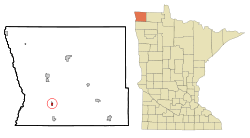Kennedy, Minnesota
Kennedy is a city in Kittson County, Minnesota, United States. The population was 193 at the 2010 census.[6]
Kennedy | |
|---|---|
 Location of Kennedy, Minnesota | |
| Coordinates: 48°38′33″N 96°54′31″W | |
| Country | United States |
| State | Minnesota |
| County | Kittson |
| Government | |
| • Mayor | Earl Mattson |
| Area | |
| • Total | 0.45 sq mi (1.16 km2) |
| • Land | 0.45 sq mi (1.16 km2) |
| • Water | 0.00 sq mi (0.00 km2) |
| Elevation | 827 ft (252 m) |
| Population | |
| • Total | 193 |
| • Estimate (2019)[3] | 180 |
| • Density | 402.68/sq mi (155.42/km2) |
| Time zone | UTC-6 (Central (CST)) |
| • Summer (DST) | UTC-5 (CDT) |
| ZIP code | 56733 |
| Area code(s) | 218 |
| FIPS code | 27-32732[4] |
| GNIS feature ID | 0646089[5] |
| Website | http://www.cityofkennedy.com/ |
History
A post office called Kennedy has been in operation since 1881.[7] The city was named for John Stewart Kennedy, a businessman and philanthropist.[8]
Geography
According to the United States Census Bureau, the city has a total area of 0.42 square miles (1.09 km2), all of it land.[9]
Demographics
| Historical population | |||
|---|---|---|---|
| Census | Pop. | %± | |
| 1900 | 158 | — | |
| 1910 | 232 | 46.8% | |
| 1920 | 311 | 34.1% | |
| 1930 | 279 | −10.3% | |
| 1940 | 338 | 21.1% | |
| 1950 | 480 | 42.0% | |
| 1960 | 458 | −4.6% | |
| 1970 | 424 | −7.4% | |
| 1980 | 405 | −4.5% | |
| 1990 | 337 | −16.8% | |
| 2000 | 255 | −24.3% | |
| 2010 | 193 | −24.3% | |
| Est. 2019 | 180 | [3] | −6.7% |
| U.S. Decennial Census 2011 estimate | |||
2010 census
As of the census[2] of 2010, there were 193 people, 89 households, and 54 families living in the city. The population density was 459.5 inhabitants per square mile (177.4/km2). There were 114 housing units at an average density of 271.4 per square mile (104.8/km2). The racial makeup of the city was 98.4% White, 1.0% Asian, and 0.5% from two or more races. Hispanic or Latino of any race were 4.1% of the population.
There were 89 households of which 27.0% had children under the age of 18 living with them, 51.7% were married couples living together, 4.5% had a female householder with no husband present, 4.5% had a male householder with no wife present, and 39.3% were non-families. 37.1% of all households were made up of individuals and 19.1% had someone living alone who was 65 years of age or older. The average household size was 2.17 and the average family size was 2.87.
The median age in the city was 47.4 years. 24.9% of residents were under the age of 18; 4.1% were between the ages of 18 and 24; 17.6% were from 25 to 44; 36.3% were from 45 to 64; and 17.1% were 65 years of age or older. The gender makeup of the city was 48.2% male and 51.8% female.
2000 census
At the 2000 census,[4] there were 255 people, 115 households and 70 families living in the city. The population density was 607.9 per square mile (234.4/km2). There were 131 housing units at an average density of 312.3 per square mile (120.4/km2). The racial makeup of the city was 99.61% White, and 0.39% from two or more races. Hispanic or Latino of any race were 6.67% of the population.
There were 115 households of which 27.0% had children under the age of 18 living with them, 55.7% were married couples living together, 3.5% had a female householder with no husband present, and 39.1% were non-families. 38.3% of all households were made up of individuals and 13.9% had someone living alone who was 65 years of age or older. The average household size was 2.22 and the average family size was 2.97.
25.5% of the population were under the age of 18, 4.7% from 18 to 24, 25.1% from 25 to 44, 25.1% from 45 to 64, and 19.6% who were 65 years of age or older. The median age was 41 years. For every 100 females, there were 99.2 males. For every 100 females age 18 and over, there were 111.1 males.
The median household income was $33,438 and the median family income was $46,094. Males had a median income of $30,893 versus $19,375 for females. The per capita income for the city was $23,094. About 2.8% of families and 5.9% of the population were below the poverty line, including 13.5% of those under the age of eighteen and 4.2% of those sixty five or over.
References
- "2019 U.S. Gazetteer Files". United States Census Bureau. Retrieved July 26, 2020.
- "U.S. Census website". United States Census Bureau. Retrieved 2012-11-13.
- "Population and Housing Unit Estimates". United States Census Bureau. May 24, 2020. Retrieved May 27, 2020.
- "U.S. Census website". United States Census Bureau. Retrieved 2008-01-31.
- "US Board on Geographic Names". United States Geological Survey. 2007-10-25. Retrieved 2008-01-31.
- "2010 Census Redistricting Data (Public Law 94-171) Summary File". American FactFinder. U.S. Census Bureau, 2010 Census. Retrieved 23 April 2011.
- "Kittson County". Jim Forte Postal History. Retrieved 17 July 2015.
- Upham, Warren (1920). Minnesota Geographic Names: Their Origin and Historic Significance. Minnesota Historical Society. p. 278.
- "US Gazetteer files 2010". United States Census Bureau. Archived from the original on 2012-07-02. Retrieved 2012-11-13.
